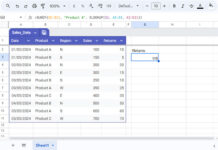Reverse Hlookup in Google Sheets is possible. To do this, you only need to rearrange the rows ‘virtually’. I mean there are no changes to the row position physically. Just change it within the Hlookup itself. How?
I’m trying to shed some light on this topic this time. See below how to do a reverse Hlookup in Google Sheets.
Reverse Hlookup in Google Sheets – What’s It?
Normally Hlookup searches across the first row for a key. In reverse Hlookup, instead of the first row, we can use any other row. But remember, there is no reverse Hlookup function!
How is Reverse Hlookup Possible in Google Sheets?
As an example, we can use Hlookup to search across the third row and return the value from the first row by rearranging the data within Hlookup. It’s very simple.
Google Sheets Reverse Hlookup Formula Example
See the below sample data.

In this, I want to find the ‘date of birth’ of “Student 2”. That means “Student 2” is the search key in Hlookup. But it’s in the third row.
Hlookup can only search across the first row. In order to do a reverse Hlookup in Google Sheets first rearrange the data as below (this we want to do within Hlookup).
{A3:E3;A1:E2}You should apply this formula within the Hlookup as the range. By doing so, Google Sheets places the third row above the first row. Now the column with the names is in the first row and the row containing the ‘date of birth’ is the second row.
In this new range, Hloookup is possible. See the reverse Hlookup formula now.
=HLOOKUP("Student 2",{A3:E3;A1:E2},2,false)This formula, as usual searches across the first row for the student name “Student 2” and returns the date of birth from the second row. It is possible with the rearranging of rows.
In concise, whenever you want to do a reverse/backward Hlookup, rearrange the rows in your data that within the Hlookup formula.
Similar:





















